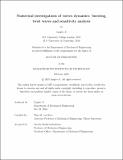Numerical investigations of vortex dynamics: bursting, twist waves, and sensitivity analysis
Author(s)
Ji, Lingbo
DownloadThesis PDF (86.40Mb)
Advisor
van Rees, Wim M.
Terms of use
Metadata
Show full item recordAbstract
Vortical structures are ubiquitous in real-world fluid flows, from the vortices generated by swimming fish to the wakes of aircraft and propellers. They form the backbone of high Reynolds number turbulent flows. Their dynamics are governed by non-linear processes, leading to a range of vortical instabilities that significantly influence engineering applications. Despite decades of research, many questions remain about core mechanisms responsible for the dynamic evolution of vortical structures due to the nonlinearity and complexity of flows at high Reynolds numbers. A particular scenario that lacks systematic investigation is vortices with initial core-size variations, which leads to the phenomena of twist wave propagation and vortex bursting. In this thesis, we first examine straight vortex tubes with initial core-size perturbations at high Reynolds numbers by performing high-fidelity numerical simulations. The differential rotation along the vortex tubes generates twist wave packets that propagate and collide, resulting in a sudden increase in the local core size – the phenomenon of bursting. We analyze the effects of perturbation amplitudes on the detailed evolution at each stage, including the underlying mechanisms for the growth and decay of the bursting structure. The bursting process is associated with significant energy dissipation, which is quantified and compared to that of unperturbed vortex tubes. Meanwhile, vortices in real fluid flows are often nonrectilinear and experience strain from environmental or self-induced effects. We extend our study to curved vortex tubes and investigate the impact of centerline non-rectilinearity on twist wave propagation and the stability of the bursting structure. Additionally, we adopt a relatively recent geometric perspective on vortical flows and analyze the helicity dynamics during the flow evolution. To systematically initialize vortex dynamics simulations based on a late-time or time-averaged flow metric, we explore different methods for sensitivity analysis of two-dimensional vortical flows. The sensitivity values obtained are then used in gradient-based optimizations, which shows promising pathways for control and optimization of vortical flow applications. Additionally, we present a numerical study of the locomotion of a rotating cylinder pair with periodic gaits in a low Reynolds number flow. We characterize the motion pattern and efficiency of the cylinder pair through a combination of theoretical arguments and numerical simulations, which provides a foundation for potential engineering applications at the microscale. Overall, our findings provide understanding of fundamental mechanisms for vortex bursting and associated twist wave dynamics at high Reynolds numbers, explorations of sensitivity analysis for vortical flow applications, along with insights into locomotion at low Reynolds numbers.
Date issued
2025-02Department
Massachusetts Institute of Technology. Department of Mechanical EngineeringPublisher
Massachusetts Institute of Technology